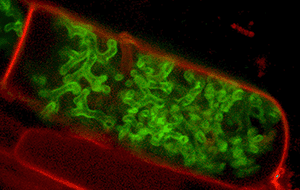News
Polar Localization of a Symbiosis-Specific Phosphate Transporter Mediator Found
 Most flowering plants form symbiotic associations with soil fungi to gain additional access to phosphate from the soil. Using live-cell imaging, researchers in the Harrison lab have identified how the plant directs phosphate transporters to the symbiotic membrane interface with the fungus. Surprisingly, targeting of the phosphate transporters is not mediated by a specific sorting motif, or by a combination of endocytosis and re-secretion (as occurs for PIN proteins involved in auxin transport). Instead, targeting to the periarbuscular membrane is driven by reorientation of secretion within the colonized cell and polarity is achieved as a consequence of temporal expression of the transporter coincident with arbuscule development.
Most flowering plants form symbiotic associations with soil fungi to gain additional access to phosphate from the soil. Using live-cell imaging, researchers in the Harrison lab have identified how the plant directs phosphate transporters to the symbiotic membrane interface with the fungus. Surprisingly, targeting of the phosphate transporters is not mediated by a specific sorting motif, or by a combination of endocytosis and re-secretion (as occurs for PIN proteins involved in auxin transport). Instead, targeting to the periarbuscular membrane is driven by reorientation of secretion within the colonized cell and polarity is achieved as a consequence of temporal expression of the transporter coincident with arbuscule development.
The work was supported by the U.S National Science Foundation (DBI-0421677 and IOS-0842720). Nathan Pumplin undertook this work while he was a graduate student in the Plant Biology Program at Cornell University. He was supported, in part, by a Cornell Presidential Life Sciences Fellowship.
For more on the Harrison Lab

